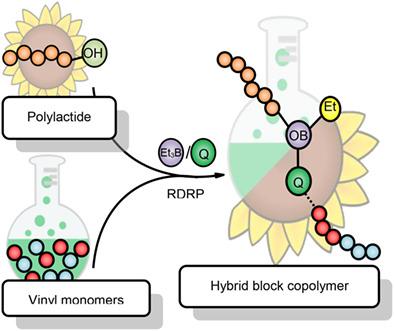当前位置:
X-MOL 学术
›
Polym. Int.
›
论文详情
Our official English website, www.x-mol.net, welcomes your
feedback! (Note: you will need to create a separate account there.)
New method for controlled synthesis of polylactide block copolymers: organoborane/p-quinone system and reversible-deactivation radical polymerization
Polymer International ( IF 2.9 ) Pub Date : 2021-08-15 , DOI: 10.1002/pi.6287 Dmitrii V. Ludin 1 , Sergey D. Zaitsev 2 , Alexey V. Markin 2 , Ivan D. Grishin 2 , Semen S. Sologubov 2 , Tatyana A. Kovylina 3 , Igor L. Fedushkin 1, 3
Polymer International ( IF 2.9 ) Pub Date : 2021-08-15 , DOI: 10.1002/pi.6287 Dmitrii V. Ludin 1 , Sergey D. Zaitsev 2 , Alexey V. Markin 2 , Ivan D. Grishin 2 , Semen S. Sologubov 2 , Tatyana A. Kovylina 3 , Igor L. Fedushkin 1, 3
Affiliation

|
We developed a new approach to obtain polylactide hybrid block copolymers with vinyl monomers (styrene, methyl methacrylate, methyl acrylate) through the realization of a reaction sequence using triethylborane and various p-quinones. The method offered includes two stages. In the first stage, a chain-transfer agent was obtained by borylation of the terminal hydroxyl groups of polylactide. The second stage was vinyl monomer radical polymerization in the presence of p-quinone accompanied by SH2-substitution at the boron atom.1,4-Naphthoquinone, 2,3-dimethyl-1,4-benzoquinone, duroquinone and 2,5-di-tert-butyl-1,4-benzoquinone were used as synthetic polymer chain growth mediators. It is shown that 1,4-naphthoquinone and 2,3-dimethyl-1,4-benzoquinone, similar in their characteristics, are effective agents providing the realization of reversible-deactivation radical polymerization. Realization of reversible-deactivation radical polymerization was proved with the analysis of the kinetics of block copolymerization, molecular weight characteristics and compositional homogeneity of block copolymers as well as its further capability to elongate the polymer chain. Synthesized block copolymers have a high thermal stability compared to the initial borylated polylactide. © 2021 Society of Industrial Chemistry.
中文翻译:

聚丙交酯嵌段共聚物可控合成新方法:有机硼烷/对醌体系和可逆失活自由基聚合
我们开发了一种新方法,通过使用三乙基硼烷和各种对醌实现反应序列,获得与乙烯基单体(苯乙烯、甲基丙烯酸甲酯、丙烯酸甲酯)的聚丙交酯杂化嵌段共聚物。提供的方法包括两个阶段。在第一阶段,通过聚丙交酯末端羟基的硼酸化得到链转移剂。第二阶段是在乙烯的存在下单体的自由基聚合p -quinone伴随被S ħ在硼atom.1,4萘醌,2,3-二甲基-1,4-苯醌,duroquinone和2,5- 2-取代二-叔-丁基-1,4-苯醌被用作合成聚合物链增长介质。结果表明,1,4-萘醌和2,3-二甲基-1,4-苯醌的特性相似,是实现可逆失活自由基聚合的有效试剂。可逆失活自由基聚合的实现通过对嵌段共聚动力学、分子量特征和嵌段共聚物的组成均匀性及其进一步拉长聚合物链的能力的分析得到证实。合成的嵌段共聚物与初始硼化聚丙交酯相比具有高热稳定性。© 2021 工业化学学会。
更新日期:2021-08-15
中文翻译:

聚丙交酯嵌段共聚物可控合成新方法:有机硼烷/对醌体系和可逆失活自由基聚合
我们开发了一种新方法,通过使用三乙基硼烷和各种对醌实现反应序列,获得与乙烯基单体(苯乙烯、甲基丙烯酸甲酯、丙烯酸甲酯)的聚丙交酯杂化嵌段共聚物。提供的方法包括两个阶段。在第一阶段,通过聚丙交酯末端羟基的硼酸化得到链转移剂。第二阶段是在乙烯的存在下单体的自由基聚合p -quinone伴随被S ħ在硼atom.1,4萘醌,2,3-二甲基-1,4-苯醌,duroquinone和2,5- 2-取代二-叔-丁基-1,4-苯醌被用作合成聚合物链增长介质。结果表明,1,4-萘醌和2,3-二甲基-1,4-苯醌的特性相似,是实现可逆失活自由基聚合的有效试剂。可逆失活自由基聚合的实现通过对嵌段共聚动力学、分子量特征和嵌段共聚物的组成均匀性及其进一步拉长聚合物链的能力的分析得到证实。合成的嵌段共聚物与初始硼化聚丙交酯相比具有高热稳定性。© 2021 工业化学学会。











































 京公网安备 11010802027423号
京公网安备 11010802027423号